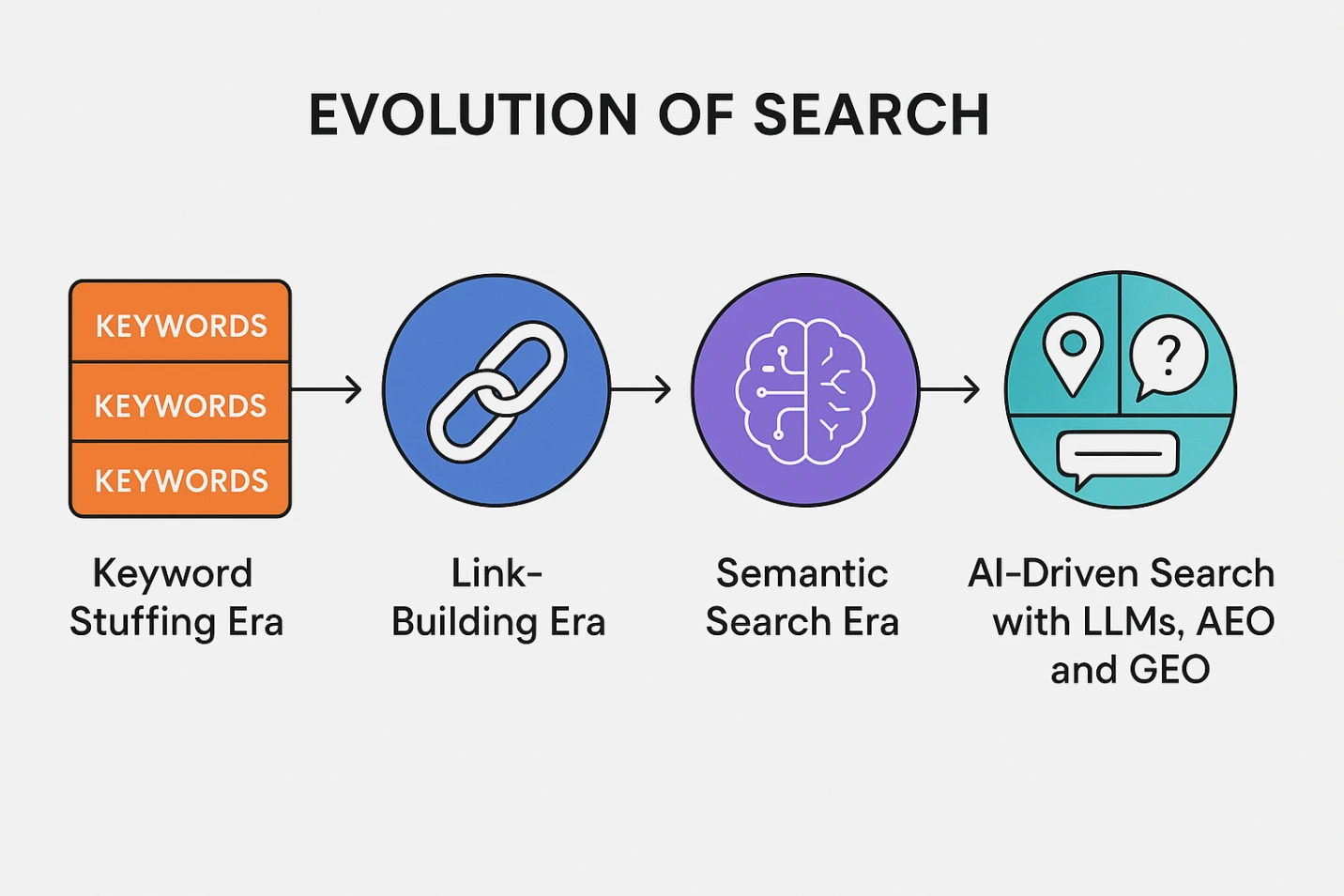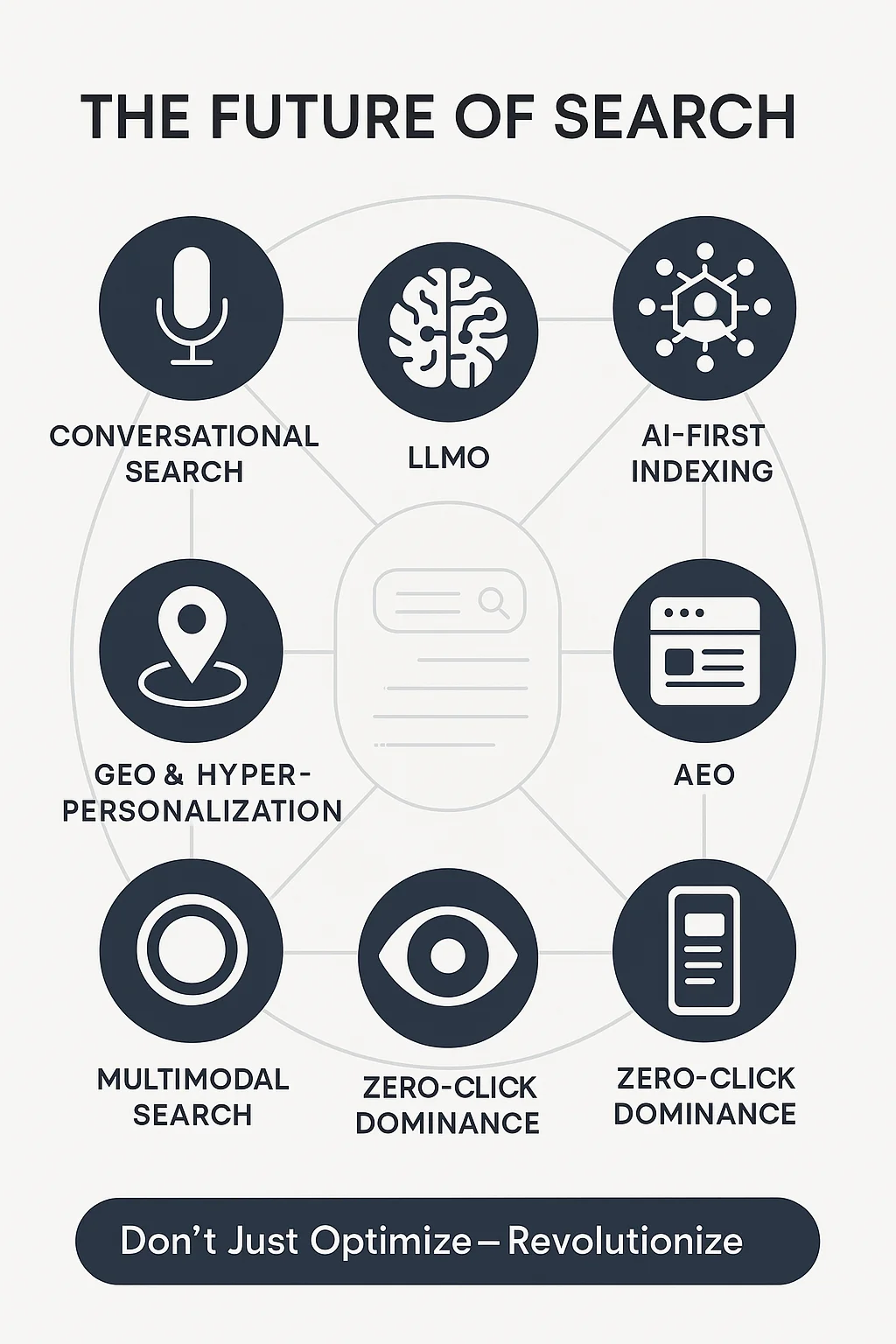From SEO to LLMO: How GEO, AEO, and AI Are Actually Redefining Search Optimization
Let’s Be Honest—SEO Isn’t What It Used to Be
Remember the days when stuffing a few keywords into your homepage and buying backlinks got you to page one of Google? Yeah those are toast.
Now, we’re in an era where search engines don’t just index your content—they interpret it.
It is the time where artificial intelligence (AI), geo-targeting (GEO), and answer engine optimization (AEO) are redefining how businesses and marketers think about search visibility.
But what’s driving this change? The rise of large language models (LLMs) like ChatGPT, Google’s Gemini, and Microsoft’s Copilot has introduced LLMO (Large Language Model Optimization)—a new frontier in digital marketing. Meanwhile, traditional SEO is evolving to include AEO (Answer Engine Optimization) for voice search and AI-driven queries, while GEO (Geo-Targeting Optimization) ensures hyper-local relevance.
So now the question arises – “Do I really need to care about all this?”—So the short answer is yes. Unless you enjoy being invisible online.
In this blog we will dive into these transformative trends, exploring how businesses and marketers can adapt to thrive in a new era of search.
What Happened to SEO?

The Evolution of Search Engines
The search engines such as Google have come a long way from being mere directories of information to complex AI-driven systems that can understand the intent behind a query. This progress has made many of the conventional SEO strategies outdated.
Here’s what’s new:
- AI Overviews & SGE (Search Generative Experience): Search engines now provide instant answers, reducing the need for users to visit external websites.
- Zero-Click Searches: SERPs often feature rich snippets or direct answers, leaving brands struggling for visibility.
As a result of this businesses now need to compete on whole new playing fields: LLMO, GEO, and AEO.
1. From SEO to LLMO: When Search Engines Start Thinking
Here’s what’s new:
- AI Overviews & SGE (Search Generative Experience): Search engines now provide instant answers, reducing the need for users to visit external websites.
- Zero-Click Searches: SERPs often feature rich snippets or direct answers, leaving brands struggling for visibility.
As a result of this businesses now need to compete on whole new playing fields: LLMO, GEO, and AEO.
Wait—what is LLMO Again?
LLMO or Large Language Model Optimization is the process of optimizing the content for AI-based platforms such as ChatGPT, Perplexity AI and Google’s Gemini. Such platforms accept natural language input, understand context and provide conversational responses, making traditional SEO techniques insufficient.
Why it Matters
- Contextual understanding (semantic search) – AI tools rely on semantics rather than exact-match keywords.
- Natural language processing (NLP) compatibility – Natural Language Processing (NLP) ensures that AI can interpret human-like questions accurately.
- Structured data for AI comprehension – AI systems thrive on structured, well-organized content.
- Authoritative, well-cited sources – AI prioritizes content from authoritative, well-cited sources.
Why Traditional SEO is No Longer Enough
- Google’s AI Overviews & SGE (Search Generative Experience) now provide direct answers, reducing clicks to websites.
- ChatGPT-style responses mean users don’t need to visit multiple pages.
- Zero-click searches dominate—brands must optimize for AI snippets, not just rankings.
How to Adapt to LLMO

- Write in a conversational, Q&A-friendly format(structured headers like “What is…”, “How does…”, etc.)
- Use schema markupto help AI understand context
- Cite authoritative sources(AI prefers well-referenced content)
- Optimize for long-tail, question-based queries(“How do I optimize for AI search?”)
2. GEO: The "Near Me" Revolution You Can’t Ignore
GEO: More Than Just a Fancy Term
If your business serves a specific location and you’re not doing Geo-Targeting Optimization, let’s just say you’re leaving money—and traffic—on the table. GEO means making sure your content is hyper-relevant locally.
“Best cafe near me.” “Dentist in Bandra.” “Digital agency in Austin.” That’s what people are actually typing—or saying—to voice assistants.
Why It’s a Big Deal
Google isn’t playing around. The Local Pack is eating up SERP real estate. AI assistants use your location data first, your content second. If you’re not geo-optimized, you’re not even in the race. GEO is critical for the below given reasons:
- Local Search Dominance: Google’s Local Pack often features geo-optimized businesses, giving them more visibility.
- Voice Search Dependency: Location-based queries are a staple of AI assistants like Siri or Alexa.
- Mobile Search Boom: Most local searches come from mobile users, making GEO indispensable.
GEO Best Practices
- Claim Your Google Business Profile: Ensure its complete, accurate, and regularly updated.
- Encourage Reviews: Positive reviews not only influence rankings but also build trust with potential customers.
- Localize Your Content: Create unique pages for each location you serve, using specific city or neighborhood names.
- Leverage Local Schema Markup: Provide search engines with metadata that reinforces your local relevance.
3. AEO: The Answer-Centric Future You Were Not Ready For
What is AEO?
Answer engine optimization (AEO) is all about being the source of direct answers provided by search engines and AI-driven tools. With users increasingly relying on voice search and AI to get quick answers, AEO helps you stay relevant.
Try This: Ask Google, “How long do you cook basmati rice?” Notice how she pulls from a specific source? That could be your site—if you optimize for AEO.

AEO ≠ SEO. Here’s Why:
SEO | AEO |
Chases rankings | Chases answers |
Focuses on traffic | Focuses on trust and clarity |
fixated on backlinks | fixated on authority & accuracy |
AEO Best Practices
- Use Question-Based Headers: Example: “How does AEO improve website traffic?”
- Add FAQs: Pair them with FAQ schema for enhanced SERP visibility.
- Keep Answers Concise: Focus on delivering accurate, clear, and short responses.
- Highlight Authority: Ensure your answers are backed by credible sources.
4. AI’s Role in All of This (a.k.a. Why You Can’t Ignore It)

The Rise of Zero-Click Searches
AI-driven search engines prioritize providing answers directly within SERPs, reducing the need for users to click on external links. This trend is reshaping how content creators approach visibility.
Google’s SGE (Search Generative Experience) is basically saying, “Why make users click when we can just tell them the answer?”
And honestly, it’s working.
Here’s the punchline: If you’re only focused on ranking #1 on Google, you’re missing where most eyeballs are actually landing—AI-generated summaries, answer boxes, snippets.
What You Need to Be Doing (Now)
- Use tools like SurferSEO or Frase to structure your content the way AI likes it
- Add citations. If you’re not backing up your claims, LLMs will skip you
- Be conversational. LLMs prefer content that sounds like a person wrote it
- Stop writing for robots from 2010—write for the robots of today
5. The Future of Search: What’s Next?

As search is changing—rapidly. It’s no longer about stuffing keywords or climbing page one. The new reality is all about context, intent, and being AI-ready. Here’s what’s in the cards:
1. Conversational Search Takes Over
Humans are searching using natural language—especially via voice assistants and AI technology. Your content needs to respond or answer in kind. Put focus on FAQs, how-to articles and answer-based writing to get more visibility
Instead of targeting “plumber services,” answer: “How much does it cost to fix a leaky faucet?”
2. LLMO (Large Language Model Optimization) Goes Mainstream
Artificial intelligence tools such as ChatGPT, Gemini, and Copilot are becoming new portals of discovery. Content must now be structured, rich in facts and readable to be surfaced and cited.
This is SEO 2.0: Being optimized to be discovered and understood by LLMs. If your current strategy still revolves around keywords and backlinks alone, it might be time to rethink your approach. Check out how SEO Services are built for today’s AI-driven search landscape—focused on context, credibility, and visibility across emerging platforms.
3. AI-First Indexing
Expect Google and others to favor content that is easily understandable by AI models and surfaced. Clear structure, semantic markup and intent based language will be key to success.
If your content is AI-friendly, it’s future-proof.
4. AEO: The Rise of Answer Engines
Search engines are now becoming answer engines. AI tools like Perplexity AI and ChatGPT are instigating more zero-click searches, where the user receives the answer without even coming to your site.
You’re not just ranking anymore—you’re competing to be the final answer.
5. GEO & Hyper-Personalization
Geo-targeted content and behavioral data will shape search results in real time. Your content must speak to specific locations, user preferences, and micro-intents.
One-size-fits-all SEO? Dead. Localized, personalized content wins.
6. Multimodal Search (Text + Voice + Image)
Users are searching with a combo of voice, photos and even screenshots. Tools like Google Lens and TikTok Search are changing the way users discover content visually.
Optimize not just your copy, but your images, alt text and even video metadata.
7. Zero-Click Search Dominance
Featured answers, AI-produced abstracts, and voice responses are driving people to click less. The solution? Organize content so your brand is the source—even if consumers don’t get to your website.
Visibility isn’t just about traffic anymore—it’s about presence where answers are being given.
Bottom Line:
The future of search is fast, visual, voice driven & AI powered. To stay relevant, your content needs to be available to both humans and machines, rich in context and always ahead of user intent.
Final Take: Don’t Just Optimize—Revolutionize

So as we know that SEO is dead and what’s taken its place is also not just a trend but a complete overhaul. From LLMO to GEO to AEO, the scene of search has totally shifted from keywords & rankings to context, conversation and credibility.
In this new era, don’t just fight to show up—compete to be the answer. Whether it’s an AI summarizing your blog, a user asking Siri a local query or someone browsing with voice and vision, the rules of visibility have changed.
The brands that will succeed tomorrow are not the ones that are still in chase of traffic in fact they are the ones already building trust, providing clarity and talking the language of humans and machines.
Key Takeaways:
- Optimize for AI (LLMO)– Structure content for ChatGPT-style answers.
- Master GEO– Dominate local search with hyper-targeted strategies.
- Prioritize AEO– Voice and AI search demand direct, concise answers.
- Leverage AI tools– Automate and enhance optimization efforts.
The future of search is AI-driven, hyper-local, and answer-focused. Are you ready?

